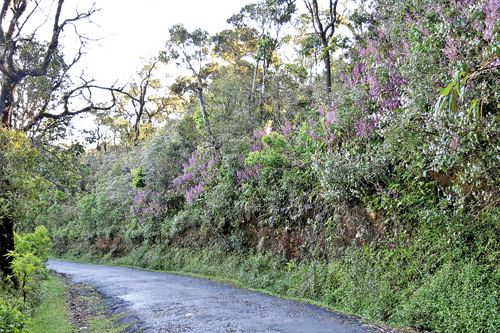Spotting Nelu flowers in bloom five years before time

Nelu blooms in abundance by the roadside
Driving to Nuwara Eliya on work recently I was informed by a friend Vimukthi Weeratunge, lead naturalist at Cinnamon Trails that the Nelu flowers were blooming on Horton Plains.
So we decided to drive up to Horton Plains national park two Sundays ago.
It turned out to be a brilliant morning after intense continuous rains for a week or more. As we ascended the plains past Pattipola, a picture book sky line welcomed us. A lone Rhododendron red was shimmering in the bright morning sun with the gigantic windmills of Ambewela, dwarfed in the background.
And then we came across the Nelu… .
The Nelu last bloomed on the plains in October /November 2013 and was expected to bloom again in 2023/2024 as per its normal flowering cycle. Why has it bloomed five years before time? Has climate change contributed to this situation, we wondered.
There are 31 species of Nelu in Sri Lanka out of which 26 varieties are endemic. We noticed four in bloom- Strobilanthus pulcherima ( light pink) Strobilanthus viscosa (white), Strobilanthus sexennies (blue) and Strobilantus calcynia (yellow). In 2013 when we last saw the Nelu in bloom , virtually the whole of the plains was covered with a blaze of pink, blue, white and yellow.
This time there were no buzzing bees nor jungle fowl feeding on the seed fall as we noticed five years ago. Maybe the intense rain fall was bringing about an early end to the flowering and also kept the fauna away.
Conservationist Rohan Pethiyagoda says in his book, ‘Sri Lanka’s Cloud Forest National Park’ – the only bloom with a resinous odour upon the completion of 10 to 12 year cycle. Certainly there was no resinous odour which filled our nostrils, only clean, salubrious air.
| Climate change the culprit? | |
| Former Director General of the Department of National Botanical Gardens Prof. Siril Wijesundara says, “It is unusual that the flowers have bloomed so early on. It could be due to climate change. However we have no scientific data to prove this. “ Prof. Wijesundara had witnessed the blooming of the Nelu flowers back in 2013 and was expecting it to bloom once again in 2025 as expected of its 12-year flowering cycle. The Nelu plants follow this pattern because once the flowers bloom, the mother plant itself dies until it is again reproduced naturally after some time.
|


